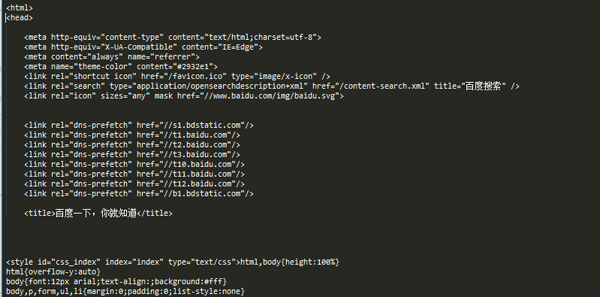Python爬蟲——寫出最簡(jiǎn)單的網(wǎng)頁爬蟲
最近對(duì)python爬蟲有了強(qiáng)烈地興趣,在此分享自己的學(xué)習(xí)路徑,歡迎大家提出建議。我們相互交流,共同進(jìn)步。
1.開發(fā)工具
筆者使用的工具是sublime text3,它的短小精悍(可能男人們都不喜歡這個(gè)詞)使我十分著迷。推薦大家使用,當(dāng)然如果你的電腦配置不錯(cuò),pycharm可能更加適合你。
sublime text3搭建python開發(fā)環(huán)境推薦查看此博客:
[sublime搭建python開發(fā)環(huán)境][http://www.cnblogs.com/codefish/p/4806849.html]
2.爬蟲介紹
爬蟲顧名思義,就是像蟲子一樣,爬在Internet這張大網(wǎng)上。如此,我們便可以獲取自己想要的東西。
既然要爬在Internet上,那么我們就需要了解URL,法號(hào)“統(tǒng)一資源定位器”,小名“鏈接”。其結(jié)構(gòu)主要由三部分組成:
(1)協(xié)議:如我們?cè)诰W(wǎng)址中常見的HTTP協(xié)議。
(2)域名或者IP地址:域名,如:www.baidu.com,IP地址,即將域名解析后對(duì)應(yīng)的IP。
(3)路徑:即目錄或者文件等。
3.urllib開發(fā)最簡(jiǎn)單的爬蟲
(1)urllib簡(jiǎn)介
| Module | Introduce |
|---|---|
| urllib.error | Exception classes raised by urllib.request. |
| urllib.parse | Parse URLs into or assemble them from components. |
| urllib.request | Extensible library for opening URLs. |
| urllib.response | Response classes used by urllib. |
| urllib.robotparser | Load a robots.txt file and answer questions about fetchability of other URLs. |
(2)開發(fā)最簡(jiǎn)單的爬蟲
百度首頁簡(jiǎn)潔大方,很適合我們爬蟲。
爬蟲代碼如下:
- from urllib import request
- def visit_baidu():
- URL = "http://www.baidu.com"
- # open the URL
- req = request.urlopen(URL)
- # read the URL
- html = req.read()
- # decode the URL to utf-8
- html = html.decode("utf_8")
- print(html)
- if __name__ == '__main__':
- visit_baidu()
結(jié)果如下圖:
我們可以通過在百度首頁空白處右擊,查看審查元素來和我們的運(yùn)行結(jié)果對(duì)比。
當(dāng)然,request也可以生成一個(gè)request對(duì)象,這個(gè)對(duì)象可以用urlopen方法打開。
代碼如下:
- from urllib import request
- def vists_baidu():
- # create a request obkect
- req = request.Request('http://www.baidu.com')
- # open the request object
- response = request.urlopen(req)
- # read the response
- html = response.read()
- html = html.decode('utf-8')
- print(html)
- if __name__ == '__main__':
- vists_baidu()
運(yùn)行結(jié)果和剛才相同。
(3)錯(cuò)誤處理
錯(cuò)誤處理通過urllib模塊來處理,主要有URLError和HTTPError錯(cuò)誤,其中HTTPError錯(cuò)誤是URLError錯(cuò)誤的子類,即HTTRPError也可以通過URLError捕獲。
HTTPError可以通過其code屬性來捕獲。
處理HTTPError的代碼如下:
- from urllib import request
- from urllib import error
- def Err():
- url = "https://segmentfault.com/zzz"
- req = request.Request(url)
- try:
- response = request.urlopen(req)
- html = response.read().decode("utf-8")
- print(html)
- except error.HTTPError as e:
- print(e.code)
- if __name__ == '__main__':
- Err()
運(yùn)行結(jié)果如圖:
404為打印出的錯(cuò)誤代碼,關(guān)于此詳細(xì)信息大家可以自行百度。
URLError可以通過其reason屬性來捕獲。
chuliHTTPError的代碼如下:
- from urllib import request
- from urllib import error
- def Err():
- url = "https://segmentf.com/"
- req = request.Request(url)
- try:
- response = request.urlopen(req)
- html = response.read().decode("utf-8")
- print(html)
- except error.URLError as e:
- print(e.reason)
- if __name__ == '__main__':
- Err()
運(yùn)行結(jié)果如圖:
既然為了處理錯(cuò)誤,那么***兩個(gè)錯(cuò)誤都寫入代碼中,畢竟越細(xì)致越清晰。須注意的是,HTTPError是URLError的子類,所以一定要將HTTPError放在URLError的前面,否則都會(huì)輸出URLError的,如將404輸出為Not Found。
代碼如下:
- from urllib import request
- from urllib import error
- # ***種方法,URLErroe和HTTPError
- def Err():
- url = "https://segmentfault.com/zzz"
- req = request.Request(url)
- try:
- response = request.urlopen(req)
- html = response.read().decode("utf-8")
- print(html)
- except error.HTTPError as e:
- print(e.code)
- except error.URLError as e:
- print(e.reason)
大家可以更改url來查看各種錯(cuò)誤的輸出形式。



































